Foreign-born people and their descendants - labour market indicators
Data extracted June 2023.
Planned article update: June 2024.
Highlights
In the EU, the employment rate in 2022 for native-born persons with only one foreign-born parent was 76.2%. This rate was lower for native-born persons with two foreign-born parents (73.7%) and for foreign-born persons (69.0%).
In the EU, the unemployment rate in 2022 for native-born persons with only one foreign-born parent was 5.6%. This rate was higher for native-born persons with two foreign-born parents (7.2%) and for foreign-born persons (9.9%).
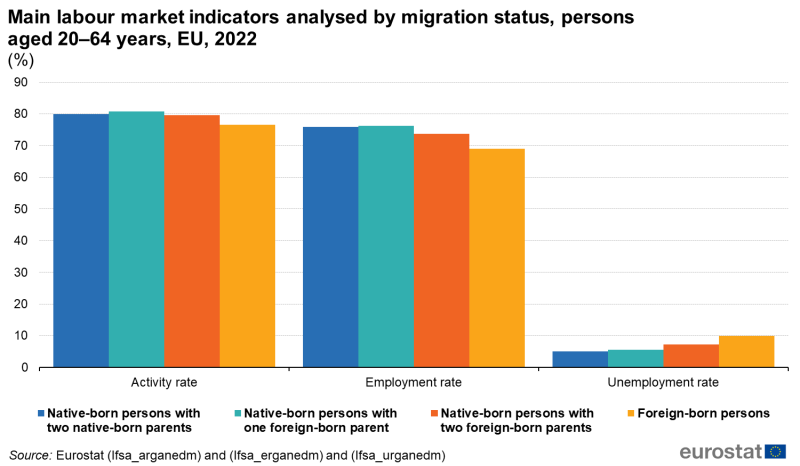
(%)
Source: Eurostat (lfsa_arganedm) and (lfsa_erganedm) and (lfsa_urganedm)
This article is one of a set of statistical articles concerning foreign-born people and their immediate descendants in the EU. This article forms part of an online publication. It presents statistics on the labour market participation of persons usually residing in private households in the European Union (EU), in its individual Member States, as well as three EFTA countries (Iceland, Norway and Switzerland). The main focus is on people aged 20-64 years and relates to three labour market indicators: activity, employment and unemployment rates.
Persons living in private households can be categorised in terms of their migration status:
- native-born with two native-born parents,
- native-born persons with at least one foreign-born parent,
- native-born persons with one foreign-born parent,
- native-born persons with two foreign-born parents,
- foreign-born persons.
An article on the main characteristics of people by migration status (based on the EU-LFS data) provides information on the relative size of these categories.
Full article
Overview
The labour force survey (EU-LFS) is the source of data for this article. For analyses of the labour market, the broadest age range typically used is 15–74 years. The main focus of this article is the age group 20–64 years. This age group is of particular interest as it is the focus for employment analyses in the Action Plan on Integration and Inclusion 2021–2027.
Three labour market indicators are presented in this article: activity rate, employment rate and unemployment rate.
- The activity rate is the proportion of people in the labour force (employed or unemployed) as a percentage of the total population.
- The employment rate is the number of employed persons (someone working as an employee, self-employed or contributing family workers) as a percentage of the total population.
- The unemployment rate is the number of unemployed persons as a percentage of the labour force.

(%)
Source: Eurostat (lfsa_arganedm) and (lfsa_erganedm) and (lfsa_urganedm)
In the EU, the activity and employment rates of native-born persons with one foreign-born parent were marginally higher in 2022 than those of native-born persons with two native-born parents. For native-born persons with two foreign-born parents, these rates were somewhat lower, they were lower still for foreign-born persons.
- The activity rate ranged from 80.7 % among native-born persons with one foreign-born parent to 76.6 % for foreign-born persons.
- The employment rate ranged from 76.2 % among native-born persons with one foreign-born parent to 69.0 % for foreign-born persons.
Native-born persons with two native-born parents had the lowest unemployment rate in 2022 when analysed by migration status, the rate being 5.1 % for the EU. The rates for native-born persons with one or two foreign-born parents were somewhat higher, at 5.6 % and 7.2 % respectively. For foreign-born persons, the unemployment rate was notably higher, at 9.9 %.
Table 1 presents data for the three principal labour market indicators and the same four categories of migration status as in Figure 1. Each of these indicators is analysed in turn in the three main sections of this article.

(%)
Source: Eurostat (lfsa_arganedm) and (lfsa_erganedm) and (lfsa_urganedm)
Activity rates
In order to see the indicators for which the gap is greatest, the data in Figures 2 to 4 and similar figures later for the employment (Figures 8 to 10) and unemployment rates (Figures 14 to 16) have been normalised. The rates for each of the four categories of migration status have been divided by the rate for native-born persons with two native-born parents. The values of the ratio for native-born persons with two native-born parents are equal by construction to 1.
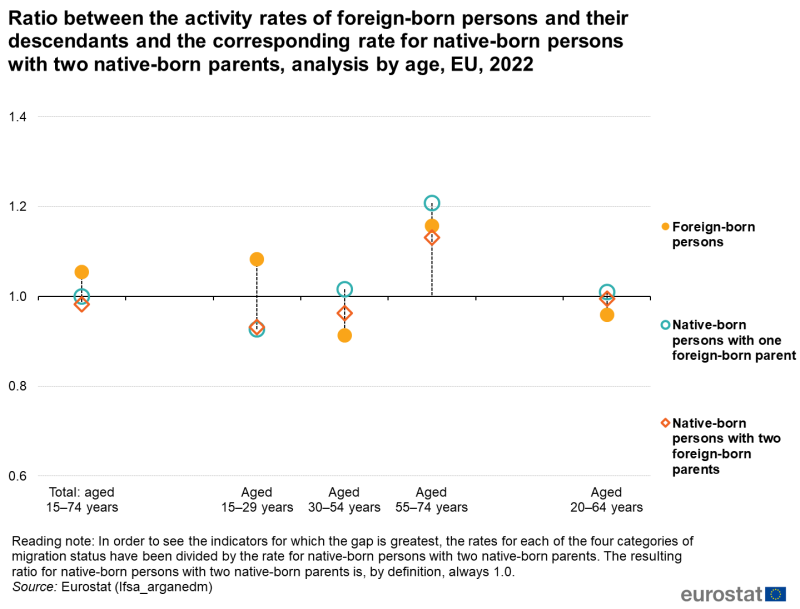
Source: Eurostat (lfsa_arganedm)
Figure 2 provides an analysis of the ratio between the activity rates of foreign-born persons and their descendants and the corresponding rate for native-born persons with two native-born parents for the EU for 2022, contrasting various age groups.
- For native-born persons with one foreign-born parent, the ratio increased across the three age groups studied. The activity rate for this migration status category was lower than that for native-born persons with two native-born parents among younger people (aged 15-29 years), somewhat higher among those aged 30-54 years and highest among older people (aged 55-74 years).
- For native-born persons with two foreign-born parents, a similar pattern was observed for the ratio, as it also increased across the three age groups studied. The activity rate for native-born persons with two foreign-born parents was lower than that for native-born persons with two native-born parents among younger people (aged 15-29 years) and slightly lower among those aged 30-54 years, while it was also highest among older people (aged 55-74 years).
- For foreign-born persons, the relation between the ratio and age were less clear. The activity rate for foreign-born persons was higher than that for native-born persons with two native-born parents among younger people (aged 15-29 years) and among older people (aged 55-74 years), while it was lower among those aged 30-54 years.
Focusing on the individual age groups, the clearest picture was for older people (aged 55-74 years). In 2022, the activity rates for the three migration status categories for foreign-born persons or descendants of foreign-born persons were clearly higher than that for native-born persons with two native-born parents.
Figure 3 provides a similar analysis of the ratio between the activity rates of foreign-born persons and their descendants and the corresponding rate for native-born persons with two native-born parents for the EU for 2022, combining sex and citizenship. Note that data are not available for female EU citizens and that some data are of low reliability. The focus is on persons aged 20-64 years.
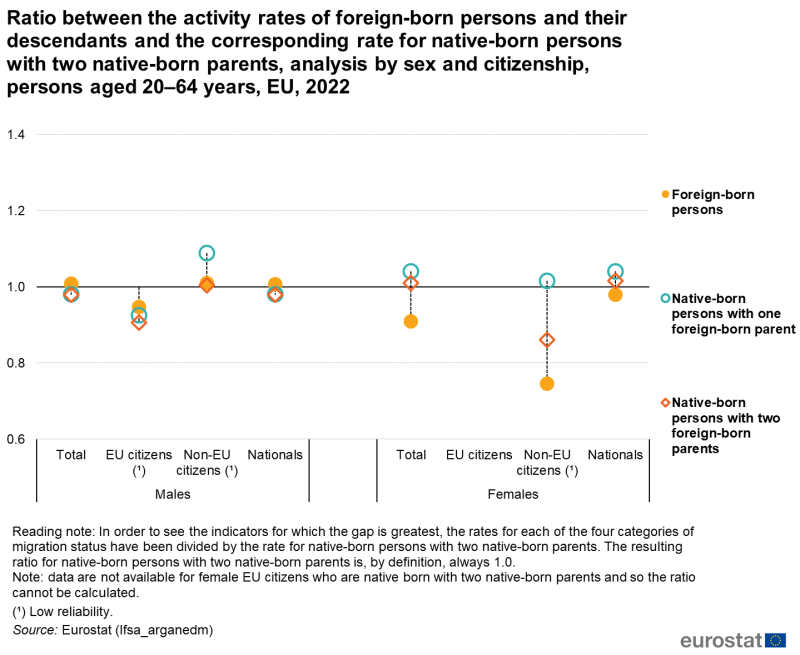
Source: Eurostat (lfsa_arganedm)
- For native-born persons with one foreign-born parent, the ratio was higher for females than for males, regardless of citizenship. Among males, only for non-EU citizens was the rate for native-born males with one foreign-born parent above that for native-born males with two native-born parents. Among females, the activity rate was higher than that for native-born females with two native-born parents in general and for both types of citizenship for which data are available. Among female non-EU citizens, those who were native born with one foreign-born parent had a notably higher activity rate than those who were native born with two native-born parents.
- For native-born persons with two foreign-born parents, a broadly similar pattern was observed. Again, the ratio was higher for females than for males in general. However, this was not the case for non-EU citizens for which a higher relative rate was observed for males rather than females.
- For foreign-born persons, there was a clear difference between the ratio of males and females. For males, activity rates for foreign-born males were quite similar to those for native-born males with two native-born parents. For females, the largest gap was observed for female non-EU citizens.
Figure 4 provides a similar analysis of the ratio between the activity rates of foreign-born persons and their descendants and the corresponding rate for native-born persons with two native-born parents for the EU for 2022, combining sex and educational attainment. The focus remains on persons aged 20-64 years.
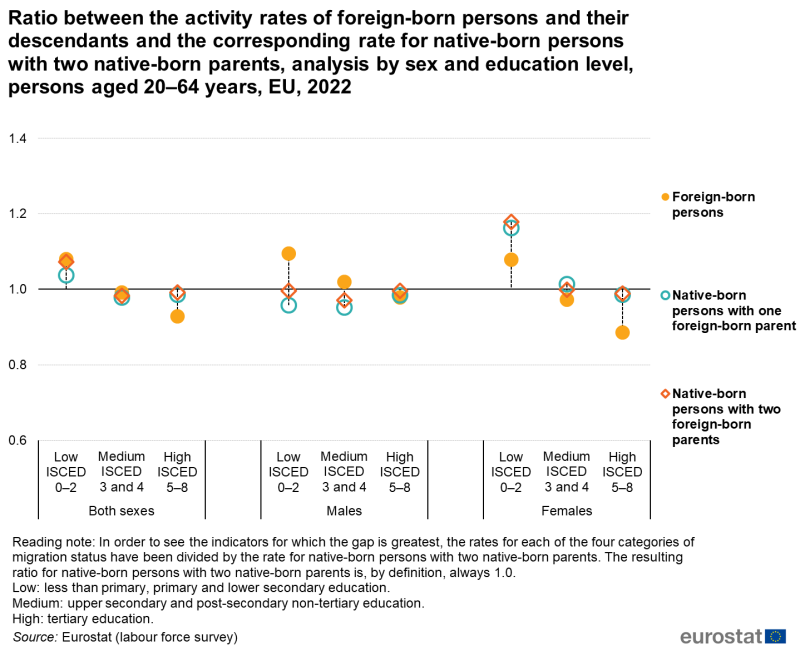
Source: Eurostat (lfsa_arganedm)
- For native-born males with one foreign-born parent, activity rates by education level were quite similar to those for native-born males with two native-born parents. The largest difference was for males having completed, at most, upper secondary or post-secondary non-tertiary education. For females, the situation was similar, but with a notably higher activity rate for those with, at most, lower secondary education.
- For native-born persons with two foreign-born parents, a broadly similar pattern was observed as for native-born persons with one foreign-born parent.
- For foreign-born persons, there was a clear progression in the value of the ratio, from higher value for persons with, at most, lower secondary education to lower value for persons with tertiary education. This was observed for males and for females.
Figures 5 to 7 compare activity rates for native-born persons with two native-born parents with, in turn, the activity rate for each of the other three categories of migration status, data are presented for 2022.
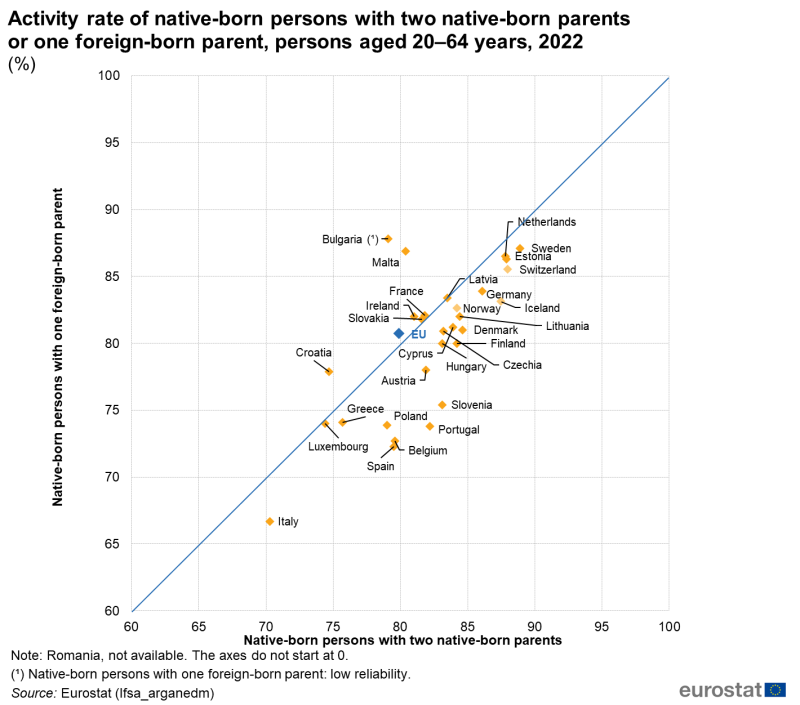
(%)
Source: Eurostat (lfsa_arganedm)
Several EU Member States recorded fairly similar activity rates in 2022 for native-born persons with one foreign-born parent and for native-born persons with two native-born parents (see Figure 5), such Member States can be identified as those whose plots are close to the diagonal line in the figure. EU Member States with a relatively high activity rate for native-born persons with two native-born parents (for example, Sweden) tended to have a high rate for native-born persons with one foreign-born parent, while the reverse was also true, with relatively low rates for both categories (for example, Luxembourg).
Among EU Member States where activity rates for native-born persons with two native-born parents were closer to the EU average, there was more variability. For example, notably higher activity rates for native-born persons with one foreign-born parent were recorded in Bulgaria (low reliability) and Malta, while notably lower rates were recorded for this category in Portugal, Slovenia, Spain, Poland and Belgium. These Member States had plots which are a greater distance from the diagonal line.
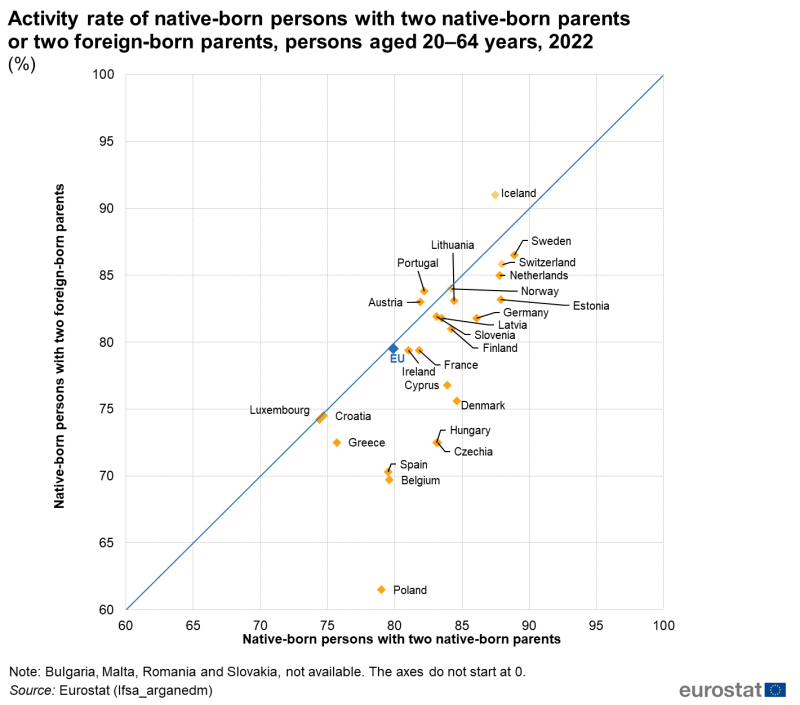
(%)
Source: Eurostat (lfsa_arganedm)
Figure 6 compares activity rates for native-born persons with two foreign-born parents and for native-born persons with two native-born parents. While there were some EU Member States which reported similar rates for both categories, for example Luxembourg and Croatia, there were others that recorded quite large differences. This can be illustrated by the rates observed for Poland that had activity rate for native-born persons with two native-born parents similar to the EU average of 79.9 %: 79.0 %. By contrast, the activity rates for native-born persons with two foreign-born parents was very different: 79.5 % (EU average) and 61.5 % (Poland).

(%)
Source: Eurostat (lfsa_arganedm)
Figure 7 presents a comparison of activity rates for foreign-born persons and for native-born persons with two native-born parents. In 2022, a few EU Member States reported similar rates for both categories, for example Cyprus, Spain, Greece, Romania and Italy, several recorded quite large differences. This can be illustrated by comparing the rates for Malta with Bulgaria. Both had activity rates for native-born persons with two native-born parents that were similar to the EU average of 79.9 %: 79.1 % in Bulgaria and 80.4 % in Malta. By contrast, their activity rates for foreign-born persons were very different: Malta recorded the highest rate among all EU Member States (89.2 %), while Bulgaria recorded the lowest rate (60.7 %).
Employment rates
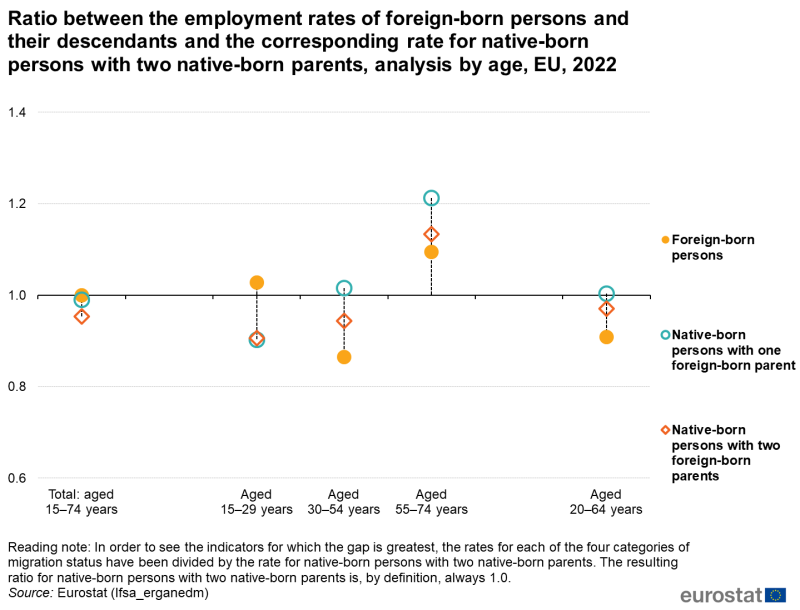
Source: Eurostat (lfsa_erganedm)
Figures 8 to 10, like Figures 2 to 4, are based on rates that have been normalised: see the box above Figure 2 for more information.
Figure 8 provides an analysis of the ratio between the employment rates of foreign-born persons and their descendants and the corresponding rate for native-born persons with two native-born parents in 2022 for the EU, contrasting various age groups.
- For native-born persons with one foreign-born parent, the ratio increased across the three age groups studied. The employment rate for this migration status was lower than that for native-born persons with two native-born parents among younger people (aged 15-29 years), slightly higher than that for native-born persons with two native-born parents among those aged 30-54 years and considerably higher among older people (aged 55-74 years).
- For native-born persons with two foreign-born parents, a similar pattern was observed for the ratio, as it also increased across the three age groups studied. The employment rate for native-born persons with two foreign-born parents was lower than that for native-born persons with two native-born parents among younger people (aged 15-29 years) and slightly lower among those aged 30-54 years. By contrast, it was notably higher among older people (aged 55-74 years).
- For foreign-born persons, the relation between the ratio and age class was less clear. Among younger people (aged 15-29 years), the employment rate for foreign-born persons was slightly higher that the one observed for native-born persons with two native-born parents. The value of the ratio for foreign-born persons was considerably lower among those aged 30-54 years while it was clearly higher among older people (aged 55-74 years).
Focusing on the individual age groups, as for the activity rate, the clearest differences by migration status for the employment rate were for older people (aged 55-74 years). In 2022, EU employment rates for the three migration status categories for foreign-born persons or descendants of foreign-born persons were clearly higher than that for native-born persons with two native-born parents.
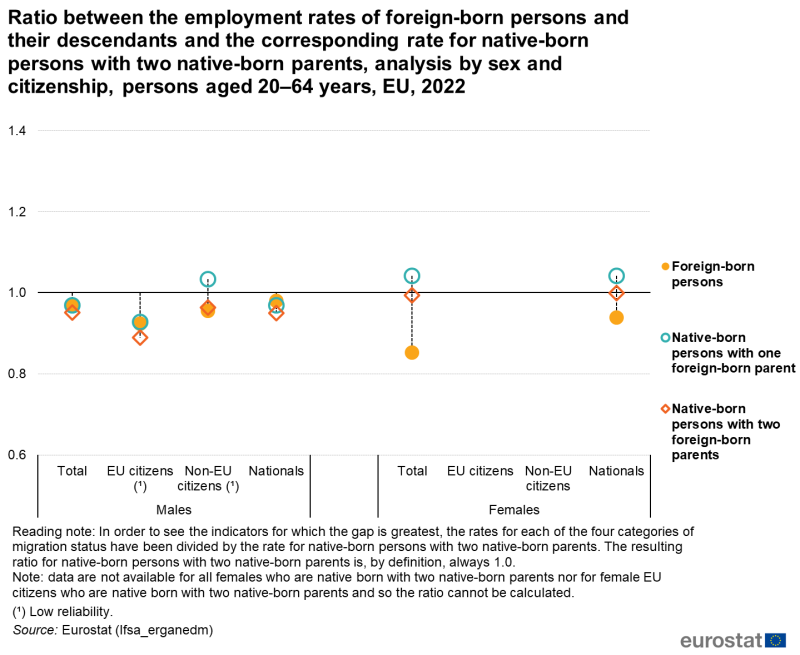
Source: Eurostat (lfsa_erganedm)
Figure 9 provides a similar analysis of the ratio between the employment rates of foreign-born persons and their descendants and the corresponding rate for native-born persons with two native-born parents in 2022 for the EU, combining sex and citizenship. Note that data are not available for female EU and non-EU citizens and that some data are of low reliability. The focus is again on persons aged 20-64 years.
- For native-born persons with one foreign-born parent, the ratio was higher for females than for males: this was the case for the total and for nationals. Among males, only for non-EU citizens was the rate for native-born males with one foreign-born parent above that for native-born males with two native-born parents. Among females, the employment rate was higher for native-born females with one foreign-born parent than that for native-born females with two native-born parents for the total as well as for nationals.
- For native-born persons with two foreign-born parents, a broadly similar pattern was observed. Again, the value of ratio was higher for females than for males for the total and for nationals. One difference compared with native-born persons with one foreign-born parent was that the employment rate for native-born females with two foreign-born parents was slightly lower than rate for native-born females with two native-born parents.
- All of the available employment rates for foreign-born persons were lower than those for native-born persons with two native-born parents, regardless of sex or citizenship. For females, some of the rates were notably lower, with a large gap for the total category.
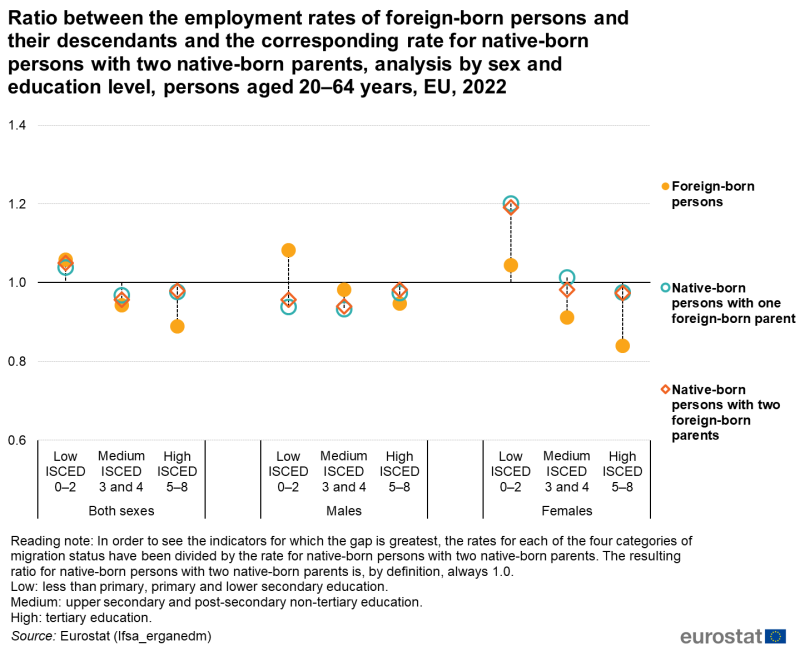
Source: Eurostat (lfsa_erganedm)
Figure 10 provides a similar analysis of the ratio between the employment rates of foreign-born persons and their descendants and the corresponding rate for native-born persons with two native-born parents in 2022 for the EU, combining sex and educational attainment. The focus remains on persons aged 20-64 years.
- For native-born males with one foreign-born parent, employment rates were lower than those for native-born males with two native-born parents, regardless of education level. The employment rate was higher for native-born females with one foreign-born parent that had, at most, lower secondary education. For females with medium or high education levels, employment rates were similar for both categories of migration status.
- For native-born persons with two foreign-born parents, a similar pattern was observed as for native-born persons with one foreign-born parent.
- For foreign-born persons, there was a clear pattern for the ratio, from higher value observed for persons with, at most, lower secondary education to lower value observed for persons with tertiary education. This was observed for males and for females.
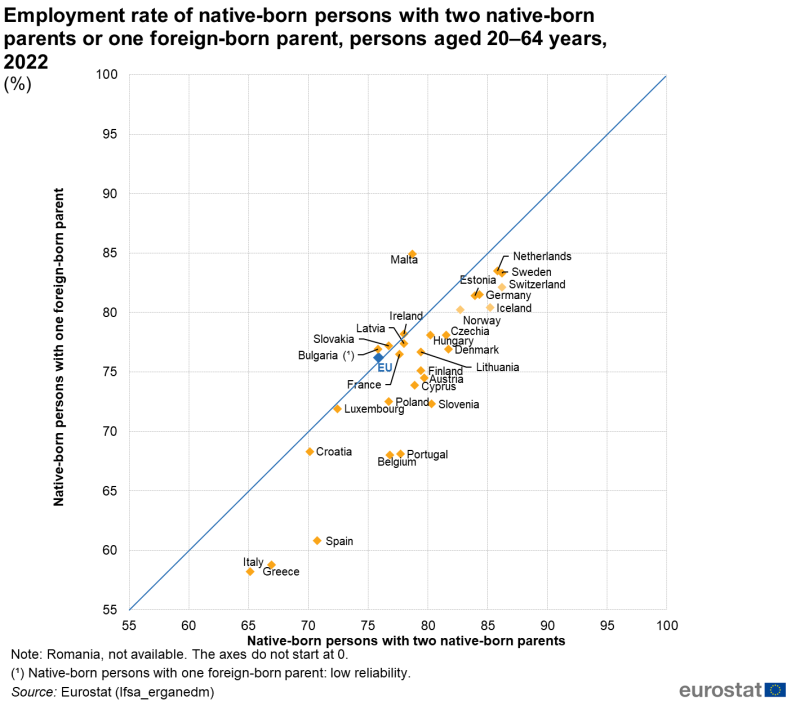
(%)
Source: Eurostat (lfsa_erganedm)
Figures 11 to 13 compare the 2022 employment rate for native-born persons with two native-born parents with, in turn, the employment rate for each of the other three categories of migration status.
A large majority of EU Member States recorded lower employment rates in 2022 for native-born persons with one foreign-born parent than for native-born persons with two native-born parents (see Figure 11). The only ones who recorded higher rates for native-born persons with one foreign-born parent were Bulgaria (low reliability), Slovakia, Malta and Ireland. Nevertheless, EU Member States with a relatively high rate for native-born persons with two native-born parents (for example, the Netherlands and Sweden) tended to have a high rate for native-born persons with one foreign-born parent too, while the reverse was also true, with relatively low rates for both categories (for example, in Italy and Greece).
Compared with the employment rates for native-born persons with two native-born parents, particularly low employment rates for native-born persons with one foreign-born parent were observed for Portugal and Spain, with differences of almost 10 percentage points (pp) in 2022.
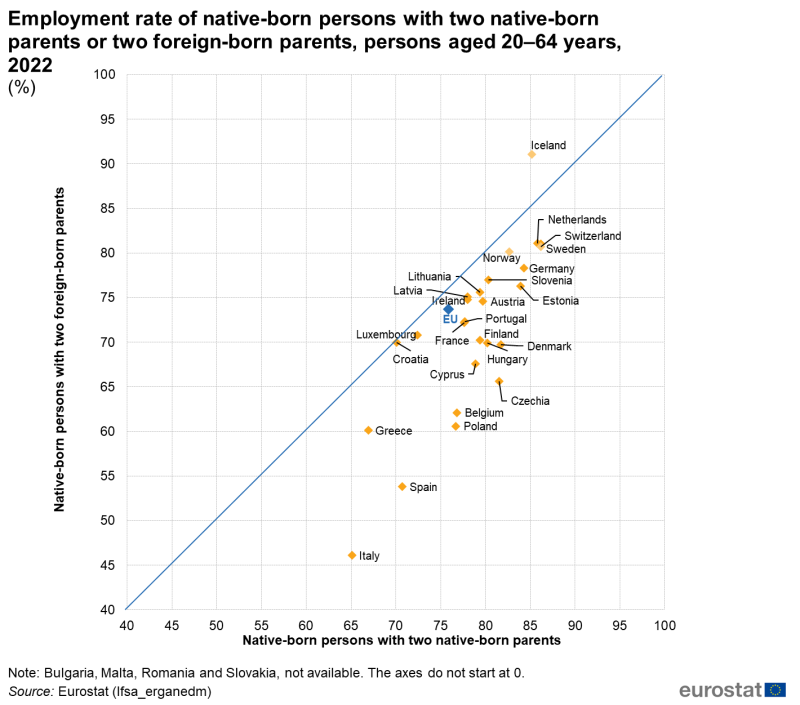
(%)
Source: Eurostat (lfsa_erganedm)
When comparing the employment rates for native-born persons with two foreign-born parents and for native-born persons with two native-born parents (see Figure 6) the situation was clearer. In 2022, there was no EU Member State to report a higher employment rate for native-born persons with two foreign-born parents than for native-born persons with two native-born parents. In Czechia, Spain and Italy employment rates for native-born persons with two foreign-born parents were more than 15.0 pp lower than those for native-born persons with two native-born parents.
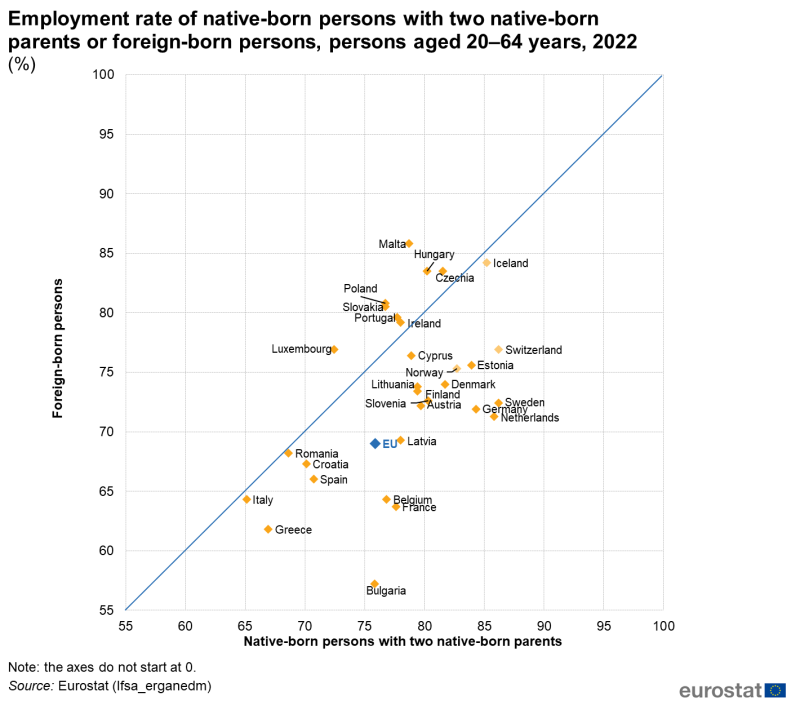
(%)
Source: Eurostat (lfsa_erganedm)
For the comparison of employment rates between foreign-born persons and native-born persons with two native-born parents the situation was a little more mixed. In 2022, there were eight EU Member States with a higher employment rate for foreign-born persons. The largest difference – with a higher rate for foreign-born persons – was observed in Malta. The remaining 19 EU Member States had lower employment rates for foreign-born persons, with differences in excess of 10 pp in Sweden, Bulgaria, the Netherlands, France, Belgium and Germany.
Unemployment rates

Source: Eurostat (lfsa_urganedm)
Figure 14 provides an analysis of the ratio between the unemployment rates of foreign-born persons and their descendants and the corresponding rate for native-born persons with two native-born parents in 2022 for the EU, contrasting various age groups.
- For native-born persons with one foreign-born parent, the ratio decreased across the three age groups studied. In other words, it had the opposite development to that observed in Figure 8 for the employment rate. The unemployment rate for this migration status category was clearly higher than that for native-born persons with two native-born parents among younger people (aged 15-29 years), was the same among those aged 30-54 years, but was lower among older people (aged 55-74 years).
- For native-born persons with two foreign-born parents, the unemployment rate was higher than that for native-born persons with two native-born parents for those aged 15-29 and those aged 30-54, however, it was lower among older people (aged 55-74 years). The largest gap for this category of migration status was for people aged 30-54 years.
- For foreign-born persons, the unemployment rate was higher for foreign-born persons than for native-born persons with two foreign-born parents for all three age groups. For persons aged 30-54 years and for those aged 55-74 years, the unemployment rate for foreign-born persons was more than double the rate for native-born persons with two native-born parents.
Among younger people (aged 15-29 years) and people aged 30-54 years, the EU unemployment rate in 2022 was higher for the three migration status categories for foreign-born persons or descendants of foreign-born persons than for native-born persons with two native-born parents.

Source: Eurostat (lfsa_urganedm)
Figure 15 provides a similar analysis of the ratio between the unemployment rates of foreign-born persons and their descendants and the corresponding rate for native-born persons with two native-born parents in 2022 for the EU, combining sex and citizenship (note that data are only available for the total and for nationals). The focus is on persons aged 20-64 years.
- For native-born persons with one foreign-born parent, the ratio was higher for males for the total and for nationals. For females the rates for native-born persons with one foreign-born parent and for native-born persons with two native-born parents were almost identical.
- For native-born persons with two foreign-born parents, the gaps were larger for native-born persons with two foreign-born parents for all combinations of sex and citizenship, with the more pronounced differences observed for males.
- For foreign-born persons, unemployment rates were always higher for foreign-born persons than for native-born persons with two native-born parents. In case of females, for the category total, the unemployment rate for foreign-born persons was more than double the rate for native-born persons with two native-born parents.

Source: Eurostat (lfsa_urganedm)
Figure 16 provides a similar analysis of the ratio between the unemployment rates of foreign-born persons and their descendants and the corresponding rate for native-born persons with two native-born parents in 2022 for the EU, combining sex and educational attainment. The focus remains on persons aged 20-64 years.
- For native-born persons with one foreign-born parent, unemployment rates by sex and education level were generally higher than those for native-born persons with two native-born parents, the one exception was for females with, at most, lower secondary education. Furthermore, for each educational attainment level, the value of the ratio was higher for males than for females.
- For native-born persons with two foreign-born parents, a broadly similar pattern was observed for the ratio as for native-born persons with one foreign-born parents. For most combinations of sex and education level, the gaps were always larger for native-born persons with two foreign-born parents than for native-born persons with one foreign-born parent.
- For foreign-born persons, for all combinations of sex and educational attainment, unemployment rates by sex and education level were generally higher than those for native-born persons with two native-born parents. The observed gaps were larger for foreign-born persons than for native-born persons with one or two foreign-born parents, the only exception being for males with, at most, lower secondary education.
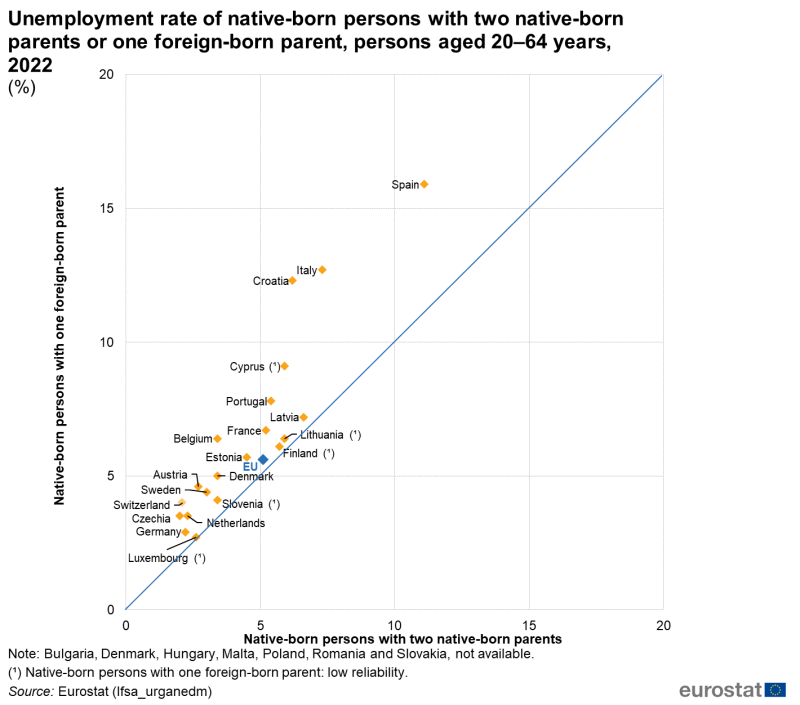
(%)
Source: Eurostat (lfsa_urganedm)
Figures 17 to 19 compare the 2022 unemployment rate for native-born persons with two native-born parents with, in turn, the unemployment rate for each of the other three categories of migration status.
All EU Member States for which data are available recorded higher unemployment rates in 2022 for native-born persons with one foreign-born parent than for native-born persons with two native-born parents (see Figure 17). Those with a relatively high rate for native-born persons with two native-born parents (for example, Greece and Spain) tended to have a high rate for native-born persons with one foreign-born parent too, while the reverse was also true, with relatively low rates for both categories (for example, Luxembourg and Germany).
In 2022, the largest difference between unemployment rates for these two categories of migration status was in Greece (9.3 pp). Several southern EU Member States – Croatia, Italy, Spain and Cyprus – also reported quite large differences. The narrowest gap for native-born persons with one foreign-born parent was in Luxembourg.
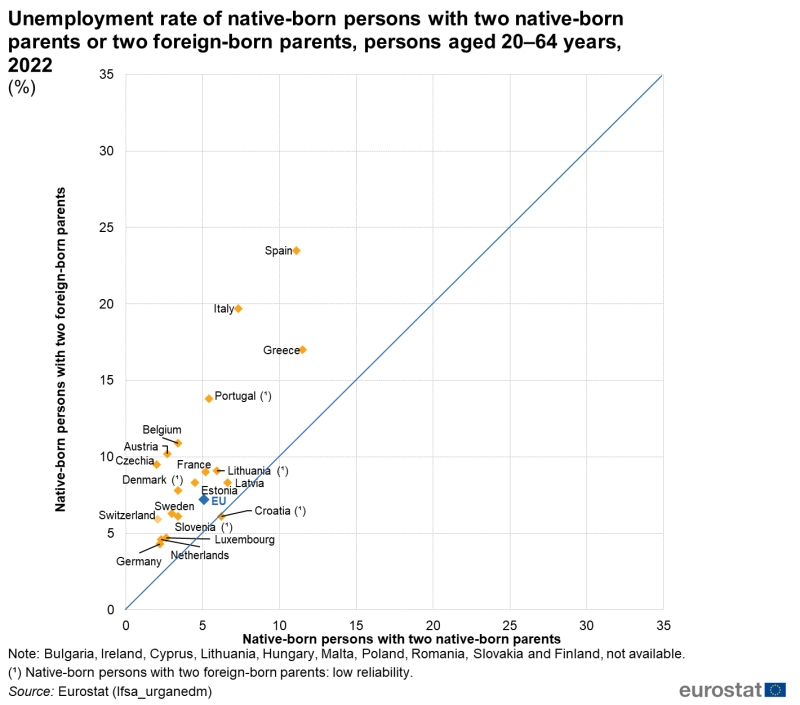
(%)
Source: Eurostat (lfsa_urganedm)
Figure 18 compares unemployment rates for native-born persons with two foreign-born parents and those for native-born persons with two native-born parents. In this presentation, unemployment rates for native-born persons with two foreign-born parents observed in 2022 were generally higher than those for native-born persons with two native-born parents, the one exception observed for Croatia (low reliability).
Spain, Italy and Greece recorded particularly high rates for native-born persons with two foreign-born parents, all in excess of 15.0 %. Spain and Italy also recorded the largest gaps: the difference between unemployment rates for native-born persons with two foreign-born parents and native-born persons with two native-born parents was 12.4 pp both in Spain and in Italy. Relatively large gaps were also observed in Portugal, Belgium, Czechia and Austria.
For foreign-born persons, the situation in 2022 was quite similar to that for native-born persons with one foreign-born parent. All EU Member States for which data are available recorded higher unemployment rates for foreign-born persons than for native-born persons with two native-born parents. Greece and Spain recorded unemployment rates that were among the highest for any EU Member State and were considerably higher than for native-born persons with two native-born parents. Despite this, the largest integration gap for foreign-born persons was observed in Sweden, where the unemployment rate for foreign-born persons was 12.0 pp above that for native-born persons with two native-born parents.
Youth unemployment rates

(%)
Source: Eurostat (lfsa_urganedm)
The final two figures in this article focus on the unemployment rate for younger people (aged 15-29 years). Across the EU, the youth unemployment rate in 2022 was 10.2 % for native-born persons with two native-born parents. This rate was somewhat higher for native-born persons with one foreign-born parent (12.5 %) and native-born persons with two foreign-born parents (12.6 %) and the highest for foreign-born persons (14.6 %).
Youth unemployment rates for 2022 are available for all four categories of migration status for 13 EU Member States (see Figure 20). In 10 of these EU Member States, the lowest unemployment rates were observed for native-born persons with two native-born parents, whereas Czechia (low reliability data for some categories), Greece and Luxembourg had a mixed situation, with the unemployment rate for some categories of migration status below that for native-born persons with two native-born parents and some above.
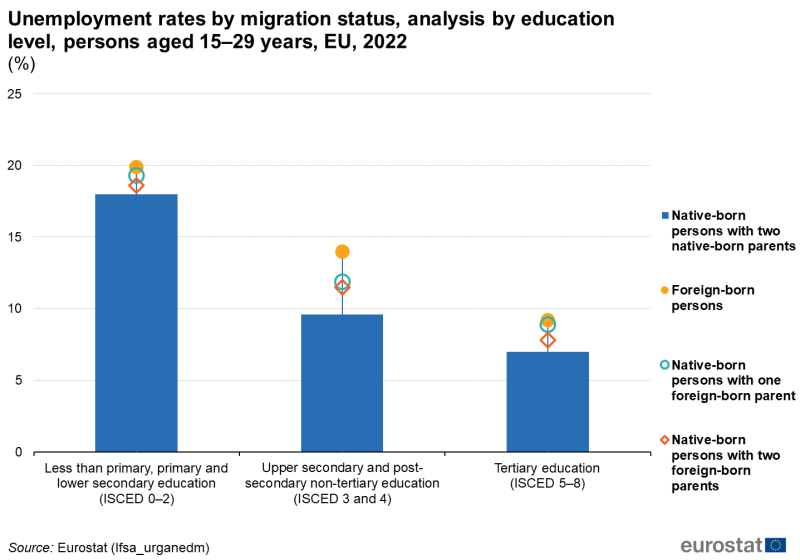
The lower youth unemployment rate in 2022 for native-born persons with two native-born parents observed across the EU as a whole was repeated for all three levels of educational attainment (see Figure 21). Regardless of education level, native-born persons with two foreign-born parents had the next lowest unemployment rate, while the highest youth unemployment rate was observed for foreign-born persons.
Source data for tables and graphs
Data sources
The data presented in this article are from the labour force survey (LFS), the largest household sample survey in the EU. The survey covers the resident population, defined as all people usually residing in private households. As such, persons living in collective households are excluded from the target population. Usual residence means the place where a person normally spends the daily period of rest, regardless of temporary absences for purposes of recreation, holidays, visits to friends and relatives, business, medical treatment or religious pilgrimage. The data for the EU are aggregated results for the 27 EU Member States. For more information on the data sources used, please consult the online publication EU labour force survey.
Due to the sampling nature of the survey, some data have low reliability or are not published due to very low reliability or confidentiality. Data that are of low reliability are duly marked in the footnotes below the figures and tables.
Main indicators
The activity rate is the percentage of active persons (also known as the labour force) in relation to the comparable total population. Active persons include employed and unemployed persons.
The employment rate is the percentage of employed persons in relation to the comparable total population. An employed person is someone aged 15 years and over who, during the reference week of the labour force survey, performed work – even if just for one hour a week – for pay, profit or family gain. Also included are people who were not at work but had a job or business from which they were temporarily absent due to illness, holiday, industrial dispute or education and training.
The unemployment rate is the number of unemployed people as a percentage of the number of active persons. An unemployed person is defined as someone simultaneously
- aged 15 to 74 years,
- not employed during the reference week according to the definition of employed persons,
- available for work, in other words available for paid employment or self-employment before the end of the two weeks following the reference week of the labour force survey and
- actively seeking work, in other words had either carried out activities in the four-week period ending with the reference week to seek paid employment or self-employment or found a job to start within a period of at most three months from the end of the reference week.
Context
The data in this article provide information not only on foreign-born persons living in the EU but also about native-born persons with at least one foreign-born parent.
Successful integration may lead to economic and social benefits for migrants and for the society where they live. More information on the policies and legislation in force in this area can be found in an introductory article on migrant integration statistics.
Direct access to
Online publications
Methodology
- LFS ad hoc modules on migrants (mii_lfso)
- LFS series – Detailed annual survey results (ESMS metadata file – lfsa_esms)
- EU labour force survey
